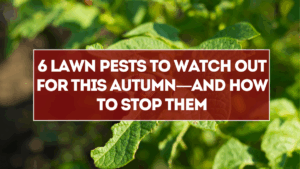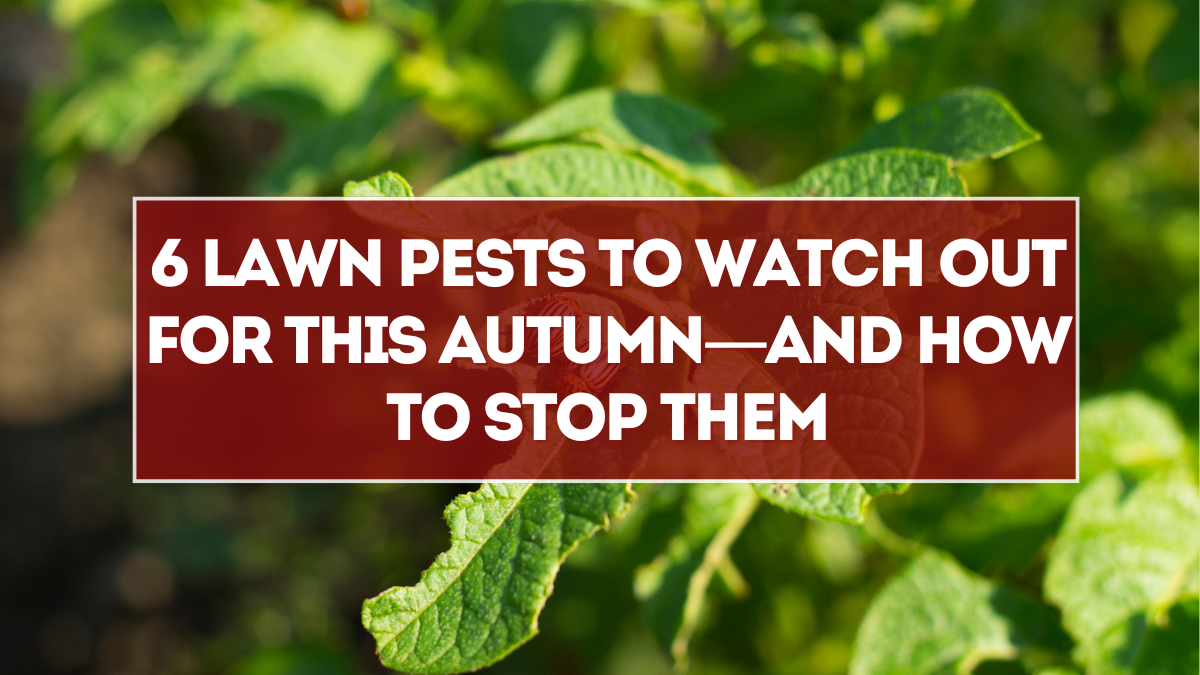A lush green lawn is often the pride of any homeowner, but autumn can bring unexpected problems in the form of pests. Cooler temperatures and moist soil conditions make lawns especially attractive to insects and small animals that feed on grass blades and roots. The key to preventing serious damage is identifying autumn lawn pests early and applying the right controls before infestations spread.
This guide highlights six of the most common fall lawn invaders—grubs, armyworms, chinch bugs, sod webworms, leatherjackets, and moles—with practical tips to stop them quickly.

Why Fall Pests Are a Problem
Many pests become more active in autumn because soil conditions favor egg-laying and larval feeding. Unlike summer drought stress, browning patches caused by pests often spread quickly and may not recover without intervention. Understanding pest behavior in cooler months helps you take preventive steps to protect your turf before winter dormancy.
1. Grubs
What they are: Grubs are the larvae of beetles such as Japanese beetles or June bugs. They live in the soil and feed on grassroots.
Signs of damage:
-
Large irregular brown patches that lift up like carpet.
-
Increased presence of birds, skunks, or raccoons digging for food.
-
Weak turf that pulls up easily with little resistance.
Fix:
Apply a grub-control product in early autumn when larvae are small and most vulnerable. Water it into the soil for best effect. Natural solutions like beneficial nematodes also work well for long-term control. Maintaining healthy, well-aerated soil discourages infestations.
2. Armyworms
What they are: Armyworms are caterpillars that feed aggressively on grass blades, often moving in large groups across a lawn.
Signs of damage:
-
Rapid browning that spreads in streaks or patches.
-
Chewed or ragged grass blades.
-
Caterpillars visible on the soil surface during early morning or evening.
Fix:
Apply lawn-safe insecticides if infestations are heavy. For a natural approach, encourage birds and beneficial insects like wasps. Regular mowing and watering help lawns recover after damage.
3. Chinch Bugs
What they are: Tiny insects that suck sap from grass blades, injecting toxins that cause wilting and browning. They are especially harmful to drought-stressed lawns.
Signs of damage:
-
Circular yellow patches that turn brown and expand outward.
-
Grass blades that feel dry and brittle despite watering.
-
Pests visible in the thatch layer if you part the grass.
Fix:
Reduce thatch buildup, as chinch bugs hide there. Spot-treat with insecticides or use natural controls like neem oil. Keeping lawns properly irrigated makes them less vulnerable to attack.
4. Sod Webworms
What they are: The larvae of lawn moths that chew grass blades and crowns, leaving unsightly bare spots.
Signs of damage:
-
Small patches of chewed or scalped grass.
-
Thin, irregular brown areas that spread gradually.
-
Silk-lined tunnels in the soil or thatch.
Fix:
Apply a targeted lawn insecticide if populations are large. Beneficial nematodes can also be applied as an organic solution. Reseed thin areas after treatment to restore turf density.
5. Leatherjackets
What they are: The larvae of crane flies, these pests feed on grassroots and crowns during autumn and spring.
Signs of damage:
-
Yellowing patches that appear in cool, moist weather.
-
Birds pecking at the lawn to find larvae.
-
Sparse, thinning turf in shaded areas.
Fix:
Aeration and proper drainage discourage leatherjackets. In severe cases, biological controls such as nematodes are effective. Maintaining a thick lawn through overseeding makes it harder for infestations to spread.
6. Moles
What they are: Unlike insects, moles are mammals that tunnel through lawns while searching for grubs and earthworms. While they don’t eat grass directly, their tunneling uproots roots and causes ridges or mounds.
Signs of damage:
-
Raised ridges and soil mounds across the lawn.
-
Uneven turf that feels spongy when walked on.
-
Increased grub presence, as moles follow their food source.
Fix:
Address the grub problem first to reduce mole activity. Trapping is the most effective direct control, though repellents and sonic devices may provide temporary relief.
Step-by-Step Pest Management Plan
-
Identify the pest: Examine patches closely to confirm whether the damage is caused by insects, animals, or disease.
-
Test for grubs: Peel back a section of turf and count larvae. More than 5–10 per square foot indicates a problem.
-
Targeted treatment: Apply pest-specific solutions instead of blanket spraying.
-
Repair damaged turf: Overseed bare areas to restore density.
-
Strengthen lawn health: Fertilize in fall to help grass recover before winter.
Preventing Fall Pest Infestations
The best defense is prevention. Healthy lawns resist pests more effectively, so follow these tips:
-
Aerate annually to reduce compaction.
-
Keep mowing at the recommended height for your grass type.
-
Avoid overwatering, which creates conditions pests love.
-
Dethatch regularly to eliminate hiding places.
-
Encourage natural predators like birds and beneficial insects.
Why Acting Fast Matters
Ignoring pest damage in autumn can set your lawn back months. Weak, thinned turf entering winter struggles to survive cold stress and is more vulnerable to spring weeds. By spotting problems early and applying targeted fixes, you protect your investment and enjoy a greener, healthier lawn next season.
FAQs
How do I tell if my lawn has pests or just drought stress?
Drought-stressed grass usually recovers after watering, while pest damage worsens and may reveal insects or larvae in the soil.
Are chemical treatments always necessary?
Not always. Many infestations can be managed with natural solutions like nematodes, neem oil, or encouraging predator species.
Can pests return after treatment?
Yes, especially if conditions remain favorable. Regular maintenance and overseeding reduce the risk of repeat infestations.
Do moles ruin lawns permanently?
No. While their tunnels look unsightly, the grass can recover once activity stops and soil is leveled.
When is the best time to apply grub control?
Early autumn is ideal, as young larvae are easiest to eliminate before they burrow deeper into the soil.
Click here to know more.
